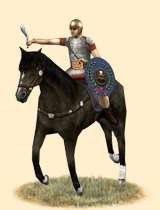Eqvites Hispanorvm (Hispanic Auxiliary Cavalry)
 |
Weapons | Defence | Mental | ||||||
|---|---|---|---|---|---|---|---|---|---|
| Primary | Secondary | Armour: | 8 | Morale: | 11 | ||||
| Type: | spear | sword | Shield: | 2 | Discipline: | normal | |||
| Attack: | 5 | 8 | Skill: | 8 | Training: | trained | |||
| Charge: | 15 | 15 | Recruitment | Other | |||||
| Lethality: | 1 | 0.11 | Soldiers: | 25 | Hit Points: | 1 | |||
| Range: | 57.8 | 0 | Cost: | 2350 | Mass: | 1 | |||
| Ammo: | 8 | 0 | Upkeep: | 588 | |||||
| Turns: | 1 | ||||||||

The tribes of the Iberian peninsula supply the roman army with effective and versatile medium horsemen that still deserves to be praised in western world.
Equites Hispanorum are a versatile medium cavalry equipped for skirmishing and close combat. The tribes of Iberia have strong equestrian traditions and their breeds are famed in many countries. Usually every rider carries multiple light javelins and a fine Iberian falcata sword for close combat, while riding an excellently trained horse. The horsemen recruited in our provinces are comparably well protected and prepared to fight the enemy even in a prolonged melee. Each eques' defensive gear consists of a good quality bascinet type bronze helmet, the widely used caetra round shield and a shirt of lorica hamata (chain mail).
Hispanic cavalry can ride down skirmishers, protect the flanks of the infantry, prepare their attack with their javelins or skirmish with the enemy’s light troops, while being always capable to charge at the right opportunity. The Spanish auxiliary cavalrymen are trained to form the cantabrian circle, the famous javelin attack formation named after one of their tribes credited with its invention, which allows the cavalrymen to stay mobile while providing a concentrated continuous missile fire against a single point at the enemy formation. However the Equites Hispanorum are still medium cavalry and a supporting force, it should never be expected that they alone can win a battle.
Historically, various auxiliary cavalry completely replaced the Italic contingents in the roman armies of the late republic. During the Punic wars and the roman expansion into the Iberian peninsula Hispanic cavalry quickly earned an outstanding reputation and many Romans considered them to be the best in the western world. After the conquest of Hispania they were commonly employed by the armies of the republic in campaigns throughout the Mediterranean. In the early Principate the finally pacified Spanish provinces, only surpassed by Gaul, remained a main source of recruits for the imperial cavalry, while Celtic and Iberian tactics, fighting style and vocabulary remained dominant well into the 2nd century AD, when the major recruitment areas for cavalrymen had shifted to the frontier provinces for many decades.
Allied and subdued states and tribes always had to supply the roman army with troops. Almost at all times at least 50% of Roma’s soldiers were non-citizens. During the first centuries of the republic the old alae of the Italic socii were organized and equipped in a similar way to the roman legions, but around the beginning of the 1st century BC the situation changed. After the social war almost all free people of Italia received roman citizenship and could now be recruited into the regular legions. In the decades after the “marian reforms” the roman light infantry disappeared. The ordo equester, since decades unable to provide a sufficient number of cavalry for the many wars the late republic had to fight, had split off in two main groups. A mainly political elite that filled out the numerous officer and administrative posts the ever growing Res Publica had to offer, and a pure economical elite, the large majority of the Roman and Italic equestrians.
The various different peoples now ruled by the republic were a much more heterogeneous group than the former Italic socii. Depending on their relative military strengths, they had to supply the roman army with the various troop types needed, besides heavy infantry, in order to be competitive on the battlefield.
Most of these troops were levied in the surrounding areas under roman control prior to campaign and only large scale or intesively prepared wars demanded additional forces and specialised units from distant areas of the Roman world. Many of the auxiliaries fought under their own chieftains and officers, while others, especially those recruited from regular provinces, were commanded by roman officers and even organized in roman manner. Usually the auxiliary units were disbanded and sent home after the end of a conflict. However, in the continuous wars during the last decades of the republic many served so long alongside the legions and fought for their generals that they were largely Romanized in the end.